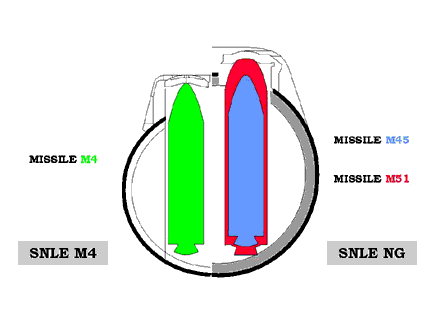





 The M-4 is an intermediate range, submarine-launched, solid propellant, MRV capable
ballistic missile. It is the fourth missile in the MSBS (Mer-Sol-Balistique-Strategique)
family which comprises a number of submarine-launched, intermediate
range missiles, similar in form to the US Polaris and Poseidon families.
The M-4 is an intermediate range, submarine-launched, solid propellant, MRV capable
ballistic missile. It is the fourth missile in the MSBS (Mer-Sol-Balistique-Strategique)
family which comprises a number of submarine-launched, intermediate
range missiles, similar in form to the US Polaris and Poseidon families.
The M-4 missile is a three stage, intermediate range missile, 11.05 m long and 1.93 m in diameter. The launch weight is 35000 kg with an inertial guidance system. The first stage burns for 62 seconds, the second for 71 seconds and the third for 43 seconds. The three stage solid propellant motors contain 20000 kg, 8015 kg and 1500 kg of propellant respectively. Each motor has a single flexible nozzle for control. The Redoutable class submarines forming France's Strategic Ocean Force have been equipped with M-4 missiles, each with six TN-70 or TN-71 nuclear warheads of 150 kt.
The range, 4000 km for M-4A and 5000 km for M-4B, is a significant improvement over that of the earlier M-20. The payload has been increased to six re-entry vehicles, which have independent targeting capability made possible by an additional guidance system incorporated within the delivery system. The TN-71 warheads have a yield of 150 kT, and each re-entry vehicle is believed to weigh about 250 kg. This would suggest a total payload capability of approximately 1700 kg. An estimated accuracy of the M-4 missile system is 500 m CEP. The M-45 variant has a range increased to 6000 km, TN-75 warheads and penetration aids.
The principal improvements in the M-4 over its predecessor, the M-20, were in range and payload, the M-4 being upgraded to include multiple re-entry vehicles. There are reported to be two versions of M-4 missile in service; the M-4A with a range of 4000 km and the M-4B with a range of 5000 km.
Initial development work for the M-4 was carried out in Le Gymnote, using twin tubes for the tests. The first test launch took place in November 1980 on the Landes test range, the 14th and final test firing taking place from Le Gymnote on 29 February 1984.
The M-4 missile entered service in 1985. The current MSBS force is based on nuclear-powered submarines SNLE (Sous-marines Nucleaire Lanceur d'Engins balistique), each able to carry 16 missiles. The M-4 is now operational in L'Inflexible, Le Tonnant, L'Indomptable, Le Terrible and Le Foudroyant. It is believed that there are 16 (one boat load) M-4A missiles and 48 (three boat loads) M-4B missiles in service.
The M-4 missiles are carried by the `L'Inflexible' class, with five SSBN in service each carrying up to 16 missiles. Logistical support for the MSBS fleet is provided by the Ile Longue naval base in Brest Bay where the assembly and storage facilities are located.
Aerospatiale developed an improved version of the M4 naval missile, the M45. The M-45 missile, armed with six TN-75 nuclear warheads, is a far more sophisticated weapon than its predecessors; its different technical characteristics allow it to respond better to the level of advancement reached by foreign defenses. It has penetration capabilities and decoy systems which allow it to divert the electronic counter-measures of an enemy's sophisticated defences. The M 45 also differs from the M 4 by the nature of the nuclear warhead (TN 75). Six of these nuclear warheads are to equip each M-45 sea-to-ground missile. Budget cuts announced in 1992 indicated that M-45 development would be re-examined. The system synthesis test firing, which qualified the M45 took place successfully from Triomphant in February 1995. The improved version, the M-45, provided a range extension to 6000 km, and in March 1986 a French boat fired an M-4 over a distance of 6000 km; the payload for this flight is not known. Proposals were made in 1988 to adapt a variant of the M-4 missile for land basing instead of developing the S-4, but these were not pursued. The M-45 variant entered service in March 1997, fitted to Le Triomphant, the first of the SNLE-NG (new generation) boats.
Compared with these TN-70 or TN-71 nuclear warhead models, the TN-75 is what the experts at the Direction des Applications Militaires du Commissariat a l'Energie Atomique (DAM-CEA) have termed to be a major technological leap. This is a particularly high-performing warhead, unprecedented in France, whose only equivalent is to be found in the most sophisticated United States or Russian weapons. It is known that the power of this thermonuclear device is some 100 kt and its load has been miniaturised to the maximum. It is also lighter than previous weapons, which increases the range of the missile. The new warhead has been hardened, which makes it less vulnerable to electromagnetic impulses which might deregulate its operation in-flight and it also has stealth features to make it less detectable and is equipped with more decoys to divert anti-ballistic missile defenses.
The need for replacing the M 45 resulted in the development beginning in 1992 of a new missile, the M 5. Falling under the concept of strict sufficiency, this program was reorientated towards the version M 51, whose range will be about 6 000 kilometers and who will be able to carry from 2015 of the nuclear heads of new generation (TNO).

Specifications |
|
| prime contractor | Aerospatiale, Space and Strategic Systems Division, Les Mureaux |
| Length | 11.05 m |
| Body diameter | 1.93 m |
| Launch weight | 35000 kg |
| Payload | 6 re-entry vehicles in MRV configuration |
| Warhead | 150 kT nuclear each |
| Guidance | Inertial plus computer payload control |
| Propulsion | 3 stage solid |
| Range | 4000 km (M-4A) 5000 km (M-4B) 6000 km (M-45) |
| Accuracy | 500 m CEP |


